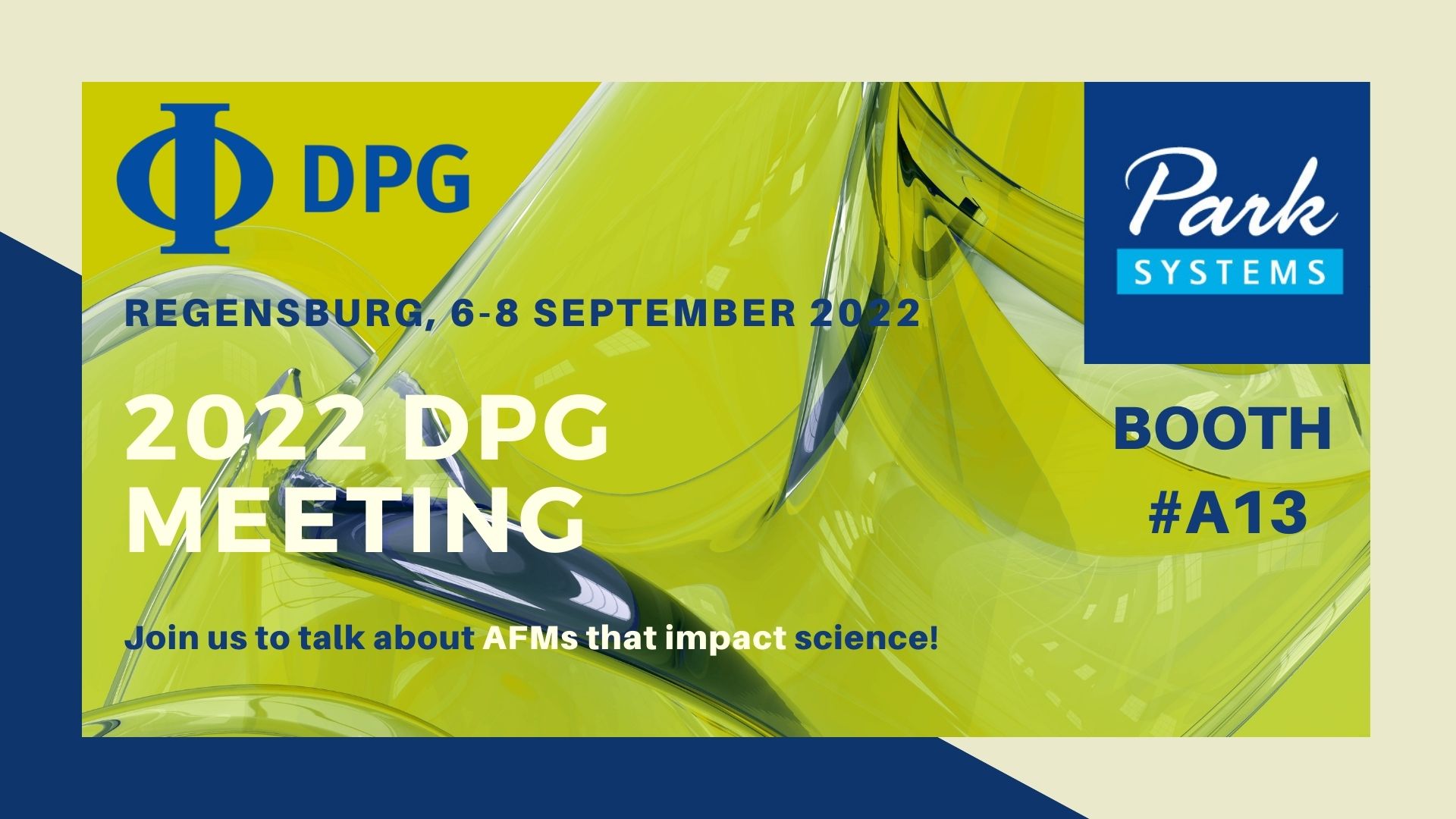
The Deutsche Physikalische Gesellschaft e. V. (DPG) will be holding its 2022 Meeting & exhibition on September 6-8, 2022 at University of Regensburg, Germany. Park Systems is delighted to join DPG 2022 as an exhibitor!
Step by Park’s booth #A13 to discuss with us the automation of nanoscale imaging process on the #FX40 Automatic AFM and its advantages for investigating materials at nanoranges! Don’t wait and book a demo slot today: pse@parksystems.com
On the top of that, we will be presenting a poster on “Exploring the Interplay of Layered Materials: Atomic Force Microscopy as a Path to Morphology and Functional Properties of Heterostructures" during the Poster Session 1 of the Chemical and Polymer Physics Division (CPP). When: Monday, September 5, 2022, 18:00–20:00, P1. Meet us at the poster stand to discuss the visualization techniques of mechanical properties on the nanoscale.
To acknowledge the best poster, Park Systems is proud to sponsor the CPP Poster Session and award the 3 best posters with prize certificates. Join the Poster Award Ceremony on Thursday, September 8, at 6pm H39 for a glass wine and snacks, to network and socialize with the valuable scientists and colleagues.
- Event Dates: 6-8 September
- Venue: Technical University of Regensburg
- Our location: booth #A13 Audimax Foyer
Poster abstract:
Exploring the Interplay of Layered Materials: Atomic Force Microscopy as a Path to Morphology and Functional Properties of Heterostructures
Presenting Author: Alexander Klasen1
Co-Authors: James Kerfoot2, Vladimir Korolkov2, Andrea Cerreta1
1Park Systems Europe GmbH, Schildkrötstraße 15, Mannheim, Germany
2 Park Systems UK Limited, MediCity Nottingham Thane Road NG90 8BH, Nottingham, UK

Fig. 1: Surface Potential (a.u.) of a hBN bilayer on graphene showing ferroelectric domains before and after switching
Single atomic layer-based systems emerged as a promising class of materials with unique optical, mechanical, and electronic properties that could provide a pathway to novel applications.1,2 Their two-dimensional nature gives rise to a wide range of tunability, since their functional properties do not only depend on the type of atoms and bonds within one plane but also on the strain, local defects, and interplay between adjacent layers.3,4
Here, we present Atomic Force Microscopy (AFM) based approaches as an ideal toolbox to map various functional properties of 2D materials and heterostructures on a nanometer scale:By investigating ferroelectric domains on a hexagonal boron nitride bilayer on a graphene single layer, we can induce domain switching when applying a constant DC potential and study them via Piezoelectric Force Microscopy.5
We will show how a force/distance-curve-based approach (PinPoint® mode) allows imaging the local conductance without any lateral force, and correlating local variations in the mechanical properties like local adhesion and Young’s modulus with the surface potential of wrinkles in graphene thin films.
We will present high-resolution images of graphene films, showing that contrast in properties like the local friction can be associated to the the moiré pattern visible in phase imaging.
Lastly, we outline a pathway for mapping the influence of light-induced degradation of MoS2 thin films and its value for future failure analysis.
In summary, we present AFM as a versatile platform to image various surface properties on a nm scale which renders this method a valuable tool for understanding 2D materials and developing future applications.
Figure 1: Surface Potential (a.u.) of a hBN bilayer on graphene showing ferroelectric domains before and after switching with +/- 3 V.
1Y. Hittori et al. ACS Nano 9, 1, 916 (2015)
2 A. Ranjan et al. ACS Appl. Electron. Mater. 3, 8, 3547 (2021)
3R. Ribeiro-Palau et al. Science 361, 6403, 690 (2018)
4U. Zerweck et al. Phys. Rev. B, 71 (2005), 125424
5C. R. Woods et al. Nat Commun. 12, 347 (2021)
About the DPG Society:
Founded in 1845, the Deutsche Physikalische Gesellschaft (DPG, "German Physical Society") is the world's largest organization of physicists. The DPG's worldwide membership is cited as 62,656, as of 2016. It holds an annual conference (Jahrestagung) and multiple spring conferences (Frühjahrstagungen), which are held at various locations and along topical subjects of given sections of the DPG. The DPG serves the fields of pure and applied physics. Main aims are to bring its members and all physicists living in Germany closer together, represent their entirety outwards as well as foster the exchange of ideas between its members and foreign colleagues. The DPG binds itself and its members to advocate for freedom, tolerance, veracity and dignity in science and to be aware about the fact, that the people working in science are responsible to a particularly high extent for the configuration of the overall human activity.




